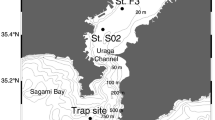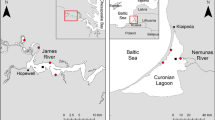Abstract
The major sources and sinks of suspended particulate carbon are identified for northern Chesapeake Bay, Maryland, USA. The area of the bay under consideration was divided into two sections. The northernmost section (upper bay), from the head of the bay to the vicinity of Baltimore, was characterized by a high input of particulate carbon from upland drainage. The section from Baltimore to the mouth of the Potomac River (middle bay) was dominated by an internal supply of particulate carbon from primary production. The northernmost section was characterized by major particulate carbon losses to the bottom and to benthic respiration, with slightly less than half (43%) of the particulate carbon respired in the water column or converted to dissolved organic matter. In contrast, respiration in the water column or conversion to dissolved organic matter was responsible for the loss of about 65% of the particulate carbon in the middle section of the bay, while losses to the bottom and to benthic respiration totaled only 12%. Even though the supply of particulate carbon to the upper bay was about 1.5 times the supply to the middle bay, the loss of carbon due to biological activity (biological efficiency) in each area was similar, and amounted to about 70% of the supply of particulate carbon.
Similar content being viewed by others
Literature cited
Beaven, G. F.: Effects of Susquehanna River flow on Chesapeake Bay salinities and history of past oyster mortalities. Rep. Md Bd nat. Resour. 1–11 (1946).
Biggs, R. B.: The sediments of Chesapeake Bay. A.A.A.S. Spec. Publ. 83 (Estuaries), 239–260 (1967).
—: Sources and distribution of suspended sediments in Northern Chesapeake Bay. Mar. Geol. 9, 187–201 (1970).
Burt, W. V.: Distribution of suspended materials in Chesapeake Bay. J. mar. Res. 14 (1), 47–62 (1955).
Carey, A. G.: Energetics of the benthos of Long Island Sound. I. Oxygen utilization of sediment. Bull. Bingham oceanogr. Coll. 19, 136–144 (1967).
Flemer, D. A.: Primary production in the Chesapeake Bay. Chesapeake Sci. 11, 117–129 (1970).
— and J. Olmon: Daylight incubation estimates of primary production in the mouth of the Patuxent River, Maryland. Chesapeake Sci. 12, 105–110 (1971).
Menzel, D. W. and R. F. Vaccaro: The measurement of dissolved and particulate carbon in seawater. Limnol. Oceanogr. 9, 138–142 (1964).
Pritchard, D. W.: Salinity distribution and circulation in the Chesapeake Bay estuarine system. J. mar. Res. 11, 106–123 (1952).
Ryan, J. D.: The sediments of Chesapeake Bay. Bull. Md Dep. Geol. Mines 12, 1–125 (1953).
Ryther, J. H.: Potential productivity of the sea. Science, N.Y. 130, 602–608 (1959).
— and C. S. Yentsch: The estimation of phytoplankton production in the ocean from chlorophyll and light data. Limnol. Oceanogr. 2, 281–286 (1957).
Schubel, J. R.: Suspended sediment of northern Chesapeake Bay. Tech. Rep. Chesapeake Bay Inst. 35, 1–263 (1966).
— and R. B. Biggs: Distribution of seston in upper Chesapeake Bay. Chesapeake Sci. 10 (1), 18–23 (1969).
Author information
Authors and Affiliations
Additional information
Communicated by J. Bunt, Miami
The research reported here was partially supported by the University of Maryland and by the U. S. Bureau of Sport Fisheries and Wildlife under Contract No. 14-16-0005-2096. Contribution No. 471 of the Natural Resources Institute, University of Maryland, USA.
Rights and permissions
About this article
Cite this article
Biggs, R.B., Flemer, D.A. The flux of particulate carbon in an estuary. Marine Biology 12, 11–17 (1972). https://doi.org/10.1007/BF00347425
Accepted:
Issue Date:
DOI: https://doi.org/10.1007/BF00347425




